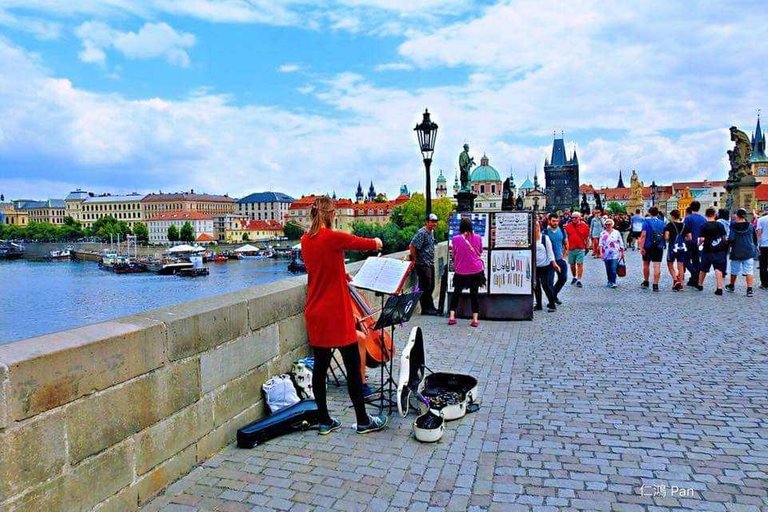The Charles Bridge (in Czech Karlův Most) - is a bridge of Prague on the Vltava River, connecting the districts of Prague Malá Strana (Small Side) and the Old Town ( Staré Město in Czech). Built in the Middle Ages this bridge has more than 30 sculptures. 520 m long, 9.5 m wide, this bridge is supported by 16 powerful arches and lined with cut stone sandstone. Until 1741 it was the only bridge on the Vltava.
The Charles Bridge is now a unique piece of medieval art. The first stone of a bridge was laid by Charles IV, July 9, 1357. At the beginning of Prague it was called "Stone Bridge", then it was renamed in 1870 in honor of its founder.
The construction of this bridge was attributed to the architect Peter Parler for a long time, but archaeological excavations proved in 2007 that the architect was in fact Oto, an unknown architect, while Peter Parler would have only completed the construction.

Strategic importance of the bridge
From Charles Bridge you can see Prague Castle and Hradcany with the East Bridge Tower.
The bridge is a link between Prague Castle and the Old Town.
Some events associated with the bridge
E
Charles Bridge. Timeless symbol of Prague
Charles Bridge History
the charles bridge in prague at night
The Charles Bridge (in Czech Karlův Most) - is a bridge of Prague on the Vltava River, connecting the districts of Prague Malá Strana (Small Side) and the Old Town ( Staré Město in Czech). Built in the Middle Ages this bridge has more than 30 sculptures. 520 m long, 9.5 m wide, this bridge is supported by 16 powerful arches and lined with cut stone sandstone. Until 1741 it was the only bridge on the Vltava.
The Charles Bridge is now a unique piece of medieval art. The first stone of a bridge was laid by Charles IV, July 9, 1357. At the beginning of Prague it was called "Stone Bridge", then it was renamed in 1870 in honor of its founder.
The construction of this bridge was attributed to the architect Peter Parler for a long time, but archaeological excavations proved in 2007 that the architect was in fact Oto, an unknown architect, while Peter Parler would have only completed the construction.
Strategic importance of the bridge
From Charles Bridge you can see Prague Castle and Hradcany with the East Bridge Tower.
The bridge is a link between Prague Castle and the Old Town.
Some events associated with the bridge
Watercolor by Dominika Brylka
The "Royal Road" crossed the bridge
In 1420, the bridge helped push back
In 1648, the Swedes attacked Prague via this bridge
In 1848, the barricades arrived at the doors of the Old Bridge Tower.
The Judith Bridge
Charles Bridge was not the first bridge over the Vltava. Around 1170 left bank and right bank of the Vltava were connected by the Yudifin bridge, also built of stone. The Yudifin Bridge was partially demolished and severely damaged during the floods of 1342. It was used at the beginning of the reign of Charles IV but for the needs of trade and population it was erected a more modern bridge.

The new bridge
The new bridge was designed by Charles IV. The construction lasted from 1357 until the beginning of the XV century. It was entrusted to Oto, an architect whose only seal is known and completed by Peter Parler. The bridge entrance goes through the Old Tower which marks the entrance to the Old City.
This tower is the gateway to the old town. It is one of the most beautiful medieval buildings of its kind in Europe. Of high artistic level, it is decorated by the emblems of the lands of the empire of Charles IV. On the door is portrayed kingfisher. Sculptures illustrating St. Vita (patron saint of the bridge), Charles IV and Wenceslas IV are on the second floor. Other sculptures of patrons from Czech countries - Saint Adalbert of Prague and Saint Sigismund are located at the top. Note also the mesh of the arches at the entrance to the west tower.
When in 1648, Prague was besieged by the Swedes, sculptures, richly decorating the gate of the tower, facing the castle, were destroyed.

Legends and highlights
According to the legend of Charles Bridge, the body of the venerated Saint John Nepomucene of the Czech Republic was abandoned from the top of the bridge. At the very spot where the saint's body was plunged into the Vltava, the glow on the water would have taken the form of 5 stars, since Nepomuk is represented with five stars.
In 1905, the bridge was electrified in order to pass a Tramway through the bridge, but this route was removed in 1908.
According to legend, Charles IV laid the foundation stone of Charles Bridge on July 9, 1357 at 5:31. Thus, the deck seating forms a 1-3-5-7-9-7-5-3-1 palindrome.

This user is on the @buildawhale blacklist for one or more of the following reasons: